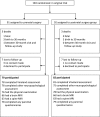Prenatal Repair of Myelomeningocele and School-age Functional Outcomes
- PMID: 31980545
- PMCID: PMC6993457
- DOI: 10.1542/peds.2019-1544
Prenatal Repair of Myelomeningocele and School-age Functional Outcomes
Abstract
Background and objectives: The Management of Myelomeningocele Study (MOMS), a randomized trial of prenatal versus postnatal repair for myelomeningocele, found that prenatal surgery resulted in reduced hindbrain herniation and need for shunt diversion at 12 months of age and better motor function at 30 months. In this study, we compared adaptive behavior and other outcomes at school age (5.9-10.3 years) between prenatal versus postnatal surgery groups.
Methods: Follow-up cohort study of 161 children enrolled in MOMS. Assessments included neuropsychological and physical evaluations. Children were evaluated at a MOMS center or at a home visit by trained blinded examiners.
Results: The Vineland composite score was not different between surgery groups (89.0 ± 9.6 in the prenatal group versus 87.5 ± 12.0 in the postnatal group; P = .35). Children in the prenatal group walked without orthotics or assistive devices more often (29% vs 11%; P = .06), had higher mean percentage scores on the Functional Rehabilitation Evaluation of Sensori-Neurologic Outcomes (92 ± 9 vs 85 ± 18; P < .001), lower rates of hindbrain herniation (60% vs 87%; P < .001), had fewer shunts placed for hydrocephalus (49% vs 85%; P < .001) and, among those with shunts, fewer shunt revisions (47% vs 70%; P = .02) than those in the postnatal group. Parents of children repaired prenatally reported higher mean quality of life z scores (0.15 ± 0.67 vs 0.11 ± 0.73; P = .008) and lower mean family impact scores (32.5 ± 7.8 vs 37.0 ± 8.9; P = .002).
Conclusions: There was no significant difference between surgery groups in overall adaptive behavior. Long-term benefits of prenatal surgery included improved mobility and independent functioning and fewer surgeries for shunt placement and revision, with no strong evidence of improved cognitive functioning.
Trial registration: ClinicalTrials.gov NCT00060606.
Copyright © 2020 by the American Academy of Pediatrics.
Conflict of interest statement
POTENTIAL CONFLICT OF INTEREST: The authors have indicated they have no potential conflicts of interest to disclose.
Comment in
-
Does prenatal surgical repair of myelomeningoceles lead to better school-age outcomes?J Perinatol. 2021 Aug;41(8):2104-2107. doi: 10.1038/s41372-020-00903-9. Epub 2020 Dec 17. J Perinatol. 2021. PMID: 33335307 No abstract available.
References
-
- Parker SE, Mai CT, Canfield MA, et al. ; National Birth Defects Prevention Network . Updated national birth prevalence estimates for selected birth defects in the United States, 2004-2006. Birth Defects Res A Clin Mol Teratol. 2010;88(12):1008–1016 - PubMed
-
- Houtrow A, Dicianno BE. Advances in spina bifida care: from the womb to adulthood. Curr Phys Med Rehabil Rep. 2014;2:71–78
-
- Norrlin S, Strinnholm M, Carlsson M, Dahl M. Factors of significance for mobility in children with myelomeningocele. Acta Paediatr. 2003;92(2):204–210 - PubMed


